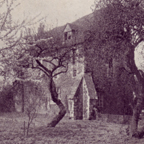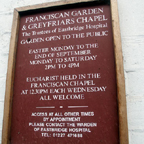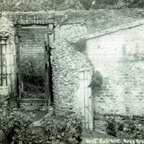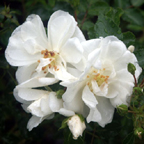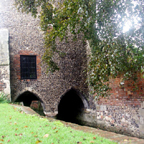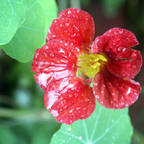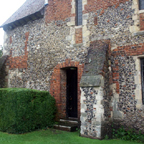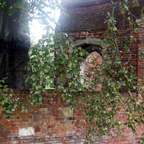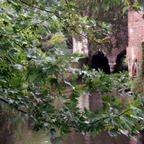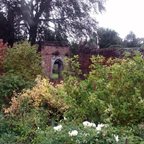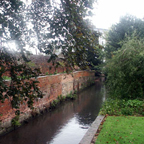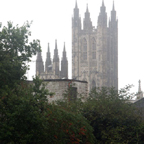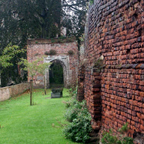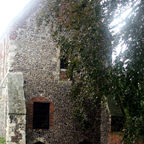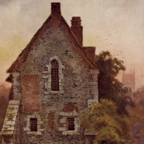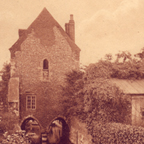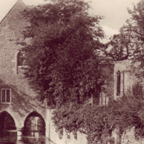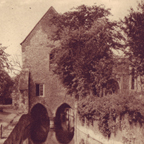
![]()
~ THE GREY FRIARS ~
CANTERBURY
The Chapel and Gardens are all that remain
The building is now back in the possession of the Franciscans
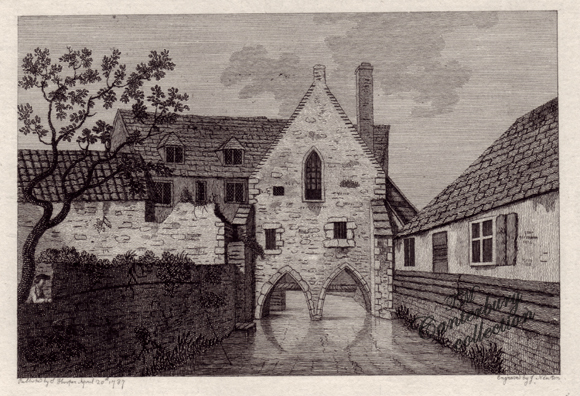
"This plate shows part of the remains of the first house of the Franciscan, or Minorite Friars, established in England. Nine in number of these bretheren first arrived here from abroad, A.D. 1224, five of whom stayed at Canterbury, by the direction of King Henry III. and settled themselves on a piece of ground near the poor priests hospital; but about the year 1270, John Diggs, an alderman of that city, translated them to an island then called Bynnewith, on the west part of the city, where they continued till the dissolution, after which the Friery was granted 31st Henry VIII. to Thomas Spelman. At present scarce any thing of the buildings, excpet the part here represented, are remaining, the outer walls and foundations excepted.
Speed and others erroneously make Henry VII. the first founder of this Friery, which was settled almost three hundred years before his time. He might (says Tanner) be a great benefactor, though Somner has not observed it, and might change the first conventual Franciscans in to that reformed branch of their order called observants, but could not be the first founder. Weaver, p. 234, tells us, this house was valued, at 39l. 12s. 8d. ob. per ann. but there is no valuation of it in either Dugdale or Speed.
This view was drawn anno 1758, published 1787."
The write up is from the drawing above in my collection
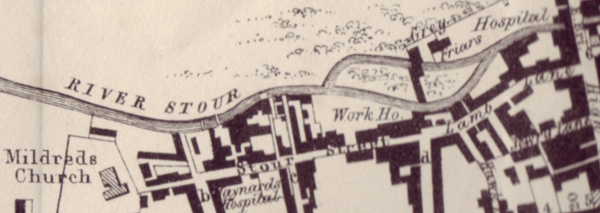
Map detail from 1843 showing the Grey Friars Hospital in the top right hand corner
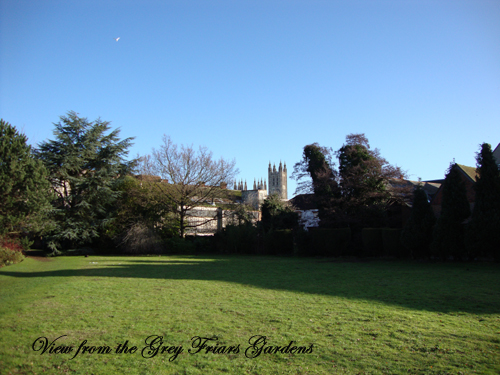
1549. The gate of the Grey Friars, in St. Peter's Street is compounded for with the Corporation and enclosed. Hasted
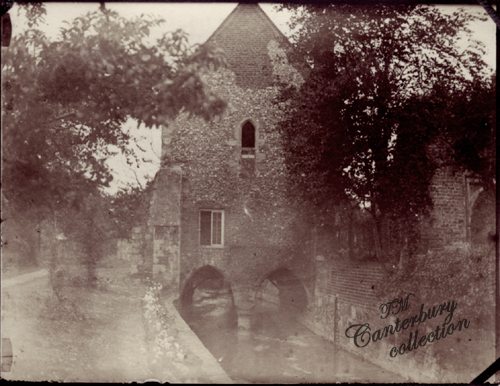
A photo postcard above in my collection of the Grey Friars
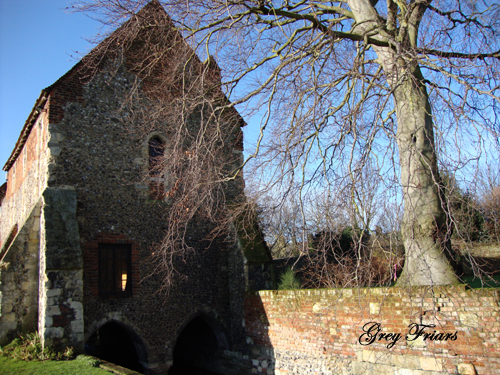
Richard Martyn
Richard Martyn* Bishop in the Universal Church, 9th November 1498. My body to be buried in the Church of the Order of the Grey Friers in Canterbury. Agnes, late my brother's wife; to the Church of Lyde my second mitre, my cross, staff, and the crosshed that Olyver the joiner made; to John Martyn, my brother's son, the farm of my Church and Vicarage of Lyde, the farm of my Church, and parsonage of Ickham; to Master John Diggys, Gentleman, my bote, with the apparel thereto belonging; to the place of Gray Friars of Canterbury my chrysmatory of silver, and parcel thereof gilt, and the case thereto belonging; in the Chapel of St. Saviour in the said Church; Edward Gylford, Prior of the House of St. Gregory of Canterbury. Proved 9th March 1502** at Canterbury.
*He was by Papal provision Bishop of St. David's, by bull dated 6 cal. Maii (April 26) 1482, he had the temporalities of that see restored to him on the 1st of July, and made his profession of obedience on the 8th of the same month in that year; Le Neve adds, "I cannot fix the certain time of his death, but believe it was in 1483. He was buried in St. Paul's Cathedral, London," and both this writer and Bishop Godwin state, that in 1483 Thomas Langton succeeded him in the Bishoprick of St. David's. There is, however, evidently an error in these statements, for it is manifest, from his will, that he was living in November 1498, and probably until March 1502-3. It is possible that in 1483 he was deprived of his spiritual dignities, but no account is recorded of the fact, and in his testament he expressly styles himself "Bishop in the Universal Church"*Query 1502 or 1503?
Testament Vetusta, 1826
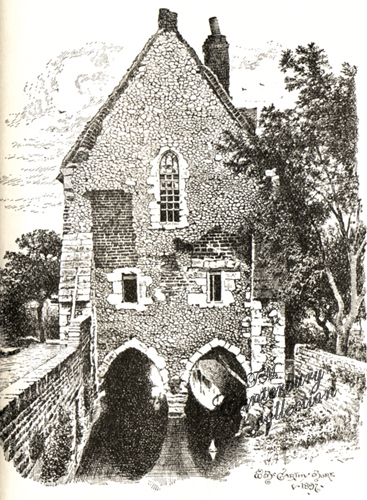
"The Franciscan, Minor, or Grey Friars first settled in England at Canterbury, on a piece of ground near the poor Priests hospital, A.D. 1224, by order of Henry III. when Diggs, an Alderman of this city, about the year 1270, translated them to an island, then called Bynnewith, on the west part of the city, where they continued till the dissolution, and was valued at 39l. 12s. 8d. ob. per annum. After which this friary was granted, in the 31st of Henry VIII., to Thomas Spilman." The Universal Magazine 1751
"A Franciscan Monastery, founded, in
1270 by John Diggs, an alderman of the city; granted, 31 Hen. VIII.,
to Thomas Spilman."
A geographical dictionary of England and Wales, William Cobbett 1832
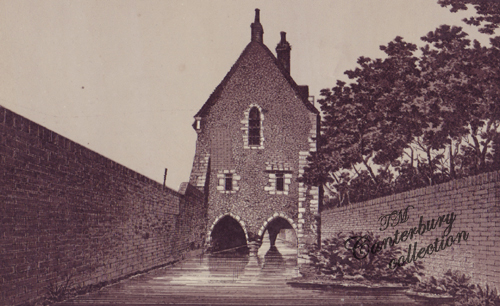
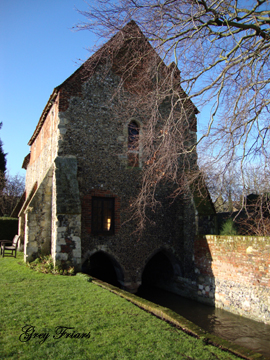
To Crumwell c. 1536
My singular good Lord, in my most hearty wise I commend me unto your lordship. And whereas I perceive that your lordship, not without urgent and godly considerations, hath suppressed already divers friars' houses, and bestowed them upon honest men as I am informed, which your godly proceeding I trust shall as well extend unto Canterbury as in other places, to the intent that the irreligious religion there may be extincted with other; and foras much as the Gray Friars in Canterbury lieth very commodiously for this bearer Thomas Cobham, brother unto my lord Cobham and my servant*, specially by cause the same is not only in his navtive country, but also nigh unto his friends; these shall be to beseech your lordship to be so good lord unto him as to help him unto the said house of the Gray Friars; for having already some land of his own, he shall be the more able to maintain the house in an honest state. And in thus doing, your lordship shall both do for the preferment of an honest man, and also make him more able to do the King's Grace service, and your lordship such pleasure as shall lie in him during his life. Thus, my lord, right heartily fare you well. At Lambeth, the vth day of October.
Your own ever assured, T. Cantuarien.
To my very singular good lord, my Lord Privy Seal.
1833 - MSS
Thomas Cranmer (T. Cantuarien)
*he was also a connexion, having married the Archbishop's niece.

Franciscans, into the Observants and Conventuals. The Observants, as Stow relates, were put down in August 1534, and Augstine friars set in their places for the time; but the Conventuals do not then appear to have be disturbed. On the contrary, Parkinson in his Antiquities of English Franciscans asserts, that "many of the Observants were sent "into the houses of the Conventuals;" and in some instances perhaps the latter may have been substituted for the former. The Act 27 Hen. VIII. cap. 28, for the suppression of the smaller religious houses in general, was passed in the Parliament which met on the 4th of Feb. 1536; but it does not seem to have been carried into execution immediately, and 1569 is mentioned as the year, when "all the Franciscan convents in the nation were taken into the King's hands, and the friars turned out of doors to shift for themselves." See Hasted, Hist. of Kent, vol. iv. p. 446. Stow, Annals. Parkinson, Collectan, Anglo-Minorit. Wood, Hist. Univ. Oxon.
The friary didn't end up going to Thomas Cobham, King Henry VIII. awarded it to Thomas Spilman*
*Thomas Spilman, of Canterbury, gentleman, was the grantee of the house of the Grey Friars in that city, and of other church lands. - Narrative of the days of the remformation 1859
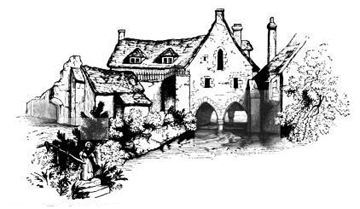
\
There are still some remains of the houses of the three orders of friars, who all established themselves in Canterbury during the thirteenth century. The GREY FRIARS, or begging friars, who settled here in 1273, had their conventual buildings in the west part of the town, on the branch of hte river Stour which runs under East Bridge. The remains of these buildings consist of a house, under which the river runs, as represented in the cut, with the ruined walls surrounding a court yard behind the railings here seen on the left hand side. With the confused asssemblage of buildings of later date, these ruins form a picturesque group. But alas! the instability of human affairs! The house of the begging friars is turned into a workhouse for paupers, and the court-yard in which the friars were wont to disport themselves, is now used for the fattening of pigs for the purpose of making brawn, an article for which Canterbury is celebrated. The fair dame of the latter establishment, in perfect innocence as to the attractions which old walls might have in the eyes of the archaeologist, supposed that our visit had reference to the mysteries of her vocation, and very obligingly shewed us into the cout in which the poor quadrupeds were confined singly in small frames, to hinder them from turning round, lest even that little share of exercise might have the effect of diminishing their obesity."
1845
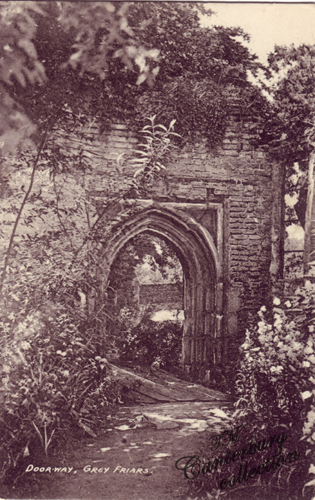 ___
___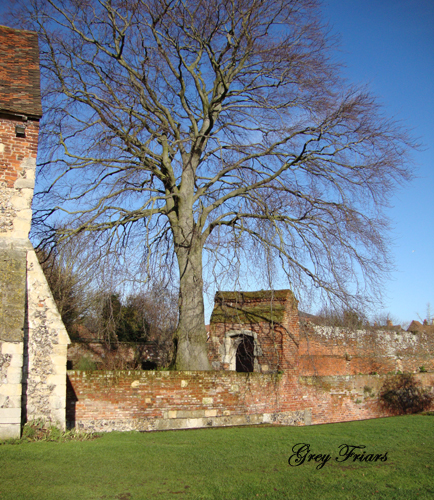
"The Convent of Grey Friars was situated on the south side of St. Peter's street, and formerly had two entrances, one from St. Peter's street called Northgate, the other called Eastgate, this entrance was by a bridge at the end of Lamb-lane, in Stour street. These friars, at first called Franciscans from the name of their founder St. Francis, were likewise called Minorities, from their being the lowest and most humble of all orders, and sometimes Observants, from their great strictness to the rules of their order. They were styled mendicants, from their professing willful poverty, subsisting chiefly upon alms, which they used to ask from door to door; by which friars were distinguished from monks, who kept at home within their convents and lived in common upon their substance; their habit was a long grey coat, down to their heels with a coul or hood, and a cord about their loins, instead of a girdle. Many privileges were granted them, and many of high degree were ambitious of living, dying, and being interred in the habit of these Franciscans. In the time of Henry VIII. the whole fraternity shared in the fate of others, and was abolished; their yearly income being valued at 39 pounds, 12s. 8 1/2d. Nothing remains of this establishment but a few walls and ruined arches; a portion of the site is now the theatre of mirth and enjoyment, being converted into tea gardens and bowling green. A fee farm rent of four shillings yearly is paid to the crown from this property."
Directory 1847
 ____
____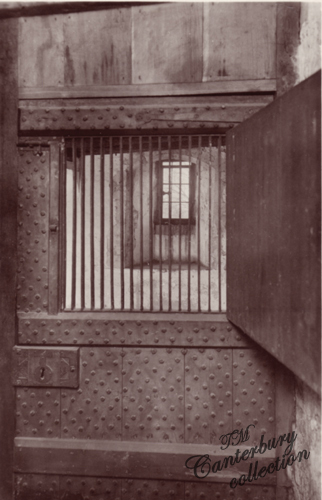
The Dormitory and the Kitchen, Grey Friars
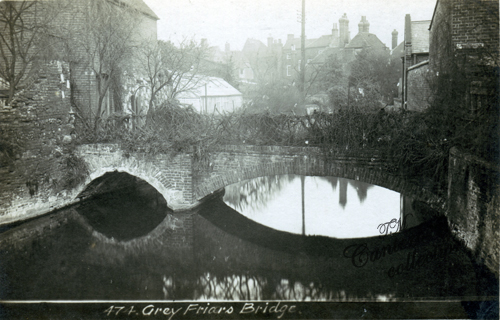
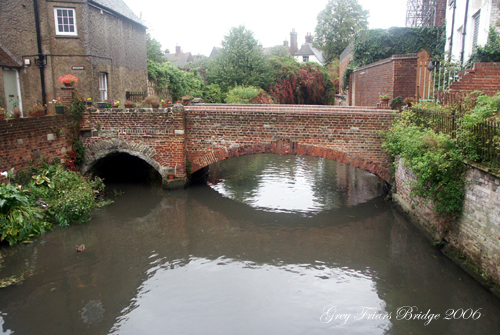
"GREY FRIARS BRIDGE" An old postcard from my collection and my 2006 photograph of the bridge
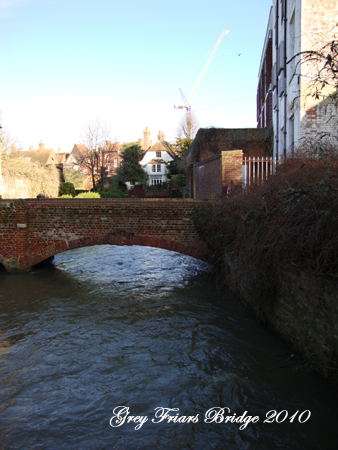
"There were three houses of friars in Canterbury, one dressed in grey, who dedicated themselves to St. Francis, a second, in black, taking St. Dominic as their patron saint and the third, in white, attached to St. Augustine. The grey friars had their dwelling in the south western part of the city, and settled in Canterbury in AD 1273: "they begged barefooted from door to door, and so were called grey, barefooted, and begging friars."
Felix Summerly 1843
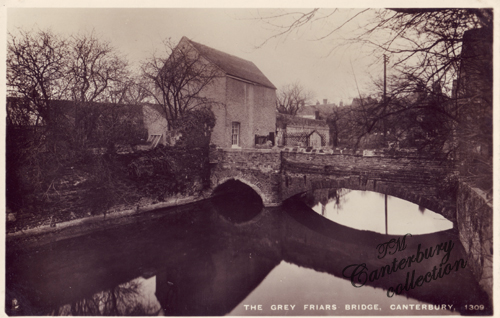
Below is a mix of old postcard's and my photo's of the Grey Friars, they are "clickable" for a larger view
1575 - April 11th A bond was given in the penalty of six pounds by the mayor and commonalty of the city of Canterbury, under their common seal, to William Lovelace, serjeant-at-law, on condition that they, whensoever the Hospital of Poor Priests, in the city of Canterbury, with the lands, tenements, and hereditaments thereunto belonging, should come into their possession they should then give the orchard in the said city, between the Stour and the then dissolved Hospital of the Grey Friars, to him and his heirs for ever, and build a bridge from his garden over the Stour to him and his heirs use for ever, then the same to be void, or else to remain in foree.
John Collymore, Mercer of St. Thomas Apostle, London, bachelor, 29 and Mable Lovelace, maiden, 18 of St. Bride, London, daughter of Sir William Lovelace, knight, of city of Canterbury, who consents; consent also of Mr. James Collymore, of St. Thomas Apostle, merchant father of said John - at St. Thomas aforesaid. 17 Feb. 1603/4. B.London Marriage Licences 1521-1869
------------------------
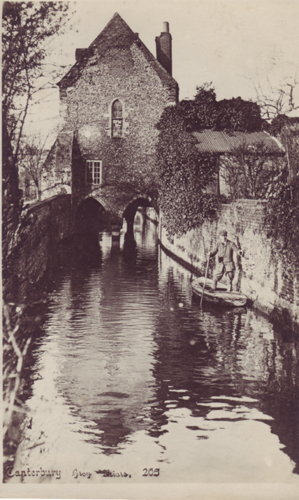
Postcard of the Grey Friars
**The principal Manor in this parish is Lydde Court....In that state the manor continued till the dissolution of the priory under Henry VIII., who soon after settled it on his new erected dean and chapter of Canterbury, by whom it was re-granted to the king, when that prince sold it to Stephen Motte and John Wyld, who alienated the same to Richard Southwell. He, in the 1st of Edward VI., passed it away by sale to Thomas Rolfe, who then conveyed the same to William Lovelace, sergeant at law, who died possessed of this estate in 1576. By his son Sir William Lovelace, of Bethersden, it was alienated to Thomas Smith, esq., of Westenhanger, ....etc.
------------------------
Robert Lade, Esq. of Barham, Recorder of Canterbury in 1663, m. in July, 1619, Mary, daughter of William Lovelace, of the Friary, Canterbury, and died in 1666, leaving, with younger issue, a son.
------------------------
Sir William Lovelace, of the Grey Friars in the city of Canterbury, by the above lease of 43 Elizabeth (1601), assigned his right and title to Patrick Crosbie of the Maryborough, Gent. in consideration of £130 good and lawful money, half in hand, and half to be paid. - Excerpt from The Gentlemen's Magazine, July 1854
**Elizabeth (Aucher) m. to Sir William Lovelace, knt. of Bethersden, in Kent, and had by him, who died in 1629, with other issue, a son, Sir William Lovelace, of Woolwich, who m. Anne, daughter of Sir William Barnes, knt. and had a son, Richard (Sir), of Lovelace Place, in Kent, who d. in 1658, leaving an only daughter and heir, Margaret, m. to Henry, fifth son of Lord Chief Justice Cook.
------------------------
Old Buildings in Canterbury - The Athenaeum, in a review of Mr. Shore's new book on Canterbury, remarks: "We are glad to see among the illustrations a good picture of the house of the Grey Friars, which stands over one of the streams of the Stour, supported by graceful arches and slender pillars of thirteenth century date. Until recently this building, which belongs to the Corporation, was in a foul state, and was virtually closed to all visitors. Lately, however, this restriction has been removed, and the building kept in a more creditable condition. The Corporation would be well advised to turn its attention to two other disgraces for which it is responsible, vis., the condition of the old Norman Castle, used as a coal store, and the sad state of the Poor Priests' Hospital, founded in 1240, and now partly used as a dwelling house and partly as a furniture store." (The writer is incorrect, we believe, in stating that the Grey Friars' house is the property of the Corporation. The present tenant is Mr. W. B. Pierce, and on application at his floral depot, St. Margaret's Street, admission tickets to this interesting house and grounds may be obtained.) K.G. & C.P., 1907
© T. Machado 2007
